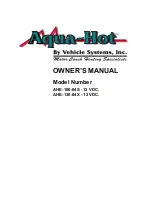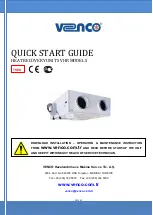
85
86
87
88
89
90
91
92
93
94
95
90
80
70
60
50
40
30
20
10
0
10
20
30
40
50
60
70
80
90
Angular Displacement (Degrees) on Horizontal Axis
Sound Pressure Level
(dB
)
at
10
ft
(3
m
)
96
4901 TrueAlert Non-Addressable Horn Installation Instructions
Table 1. TrueAlert Horn Sound Pressure Level Measurements
VOLTAGE
(VDC)
CURRENT
(mA)
HORN MODE
(See Note 1)
SOUND PRESSURE MEASUREMENT (dBA)
ANECHOIC ROOM
AVERAGE AT TEN FEET
(See Note 2)
REVERBERANT ROOM AT
TEN FEET PER UL464
(See Note 3)
16
(Minimum)
21
Steady
93
86
Coded
89
83
24
(Nominal)
23
Steady
96
89
Coded
92
85
33
(Maximum)
27
Steady
96.3
92
Coded
92.3
88
Notes:
1.
The coded category covers both Temporal and March Time
cadences.
2.
Average anechoic dBA measurements are measured on the axis in a
non-reflective test chamber using fast meter response.
3.
Reverberant dBA measurements are a minimum UL rating based on
sound power level measurements made in UL’s reverberant test
chamber.
4.
Refer to Figure 4 for directional characteristics.
5.
When used with the STI Model STI-1210D (with a flush or surface
mounted backbox) Vandal Guard, the sound output is reduced 3.1
and 6.1 dBa respectively. The guard is not listed for ULC
applications.
Notification Appliances, and the fire alarm system itself, have certain limitations and requirements for placement,
installation, and test (details on safety can be found on page 1). Since you must know the limitations and adhere to
the requirements,
keep
these instructions at a central location for future reference so that all people who use,
maintain, and test the fire alarm system have access to this information.
Notification appliances do not sense any hazardous conditions
such as smoke, fire, or explosion. They are
activated by a control panel, as part of a system that does sense such conditions.
Notification appliances do not provide their own power.
They receive their power from the fire alarm system.
If power is not supplied to the notification appliances (for whatever reason), their audible warnings will not
sound. THEREFORE, BACK-UP POWER SUPPLIES, OR OTHER BACK-UP POWER SOURCES ARE
REQUIRED FOR THE FIRE ALARM SYSTEM.
Notification appliances provide a specific rated output level of sound.
The output level must meet the
requirements of the intended protected area(s). Although the 4901 TrueAlert
horn notification appliance meets
the current UL standards for sound, the protected area(s) may have walls, doors, carpeting, furniture, insulation,
or other obstacles that reduce or even block the sound. For all applications, the sound output must provide
enough intensity to alert all occupants of the protected area(s), including those occupants that are sleeping or
hearing impaired for whatever reason. If these occupants cannot hear the notification appliances within the
protected area(s), you must increase the intensity of the sound output or add additional notification appliances so
that the occupants can hear the notification appliances when have been activated. Refer to Chapter 6 of the
National Fire Protection Association (NFPA) National Fire Alarm and Signaling Code 72 (2002 Edition).
Notification Appliances are not a substitute for insurance coverage.
All users should have adequate levels of life
and property insurance.
The placement of notification appliances must conform to:
•
Latest NFPA standards and guidelines (Refer to National Fire Alarm and Signaling Code 72, 2002 Edition,
Chapter 6)
•
Sound (sound pressure level) analysis of intended protected areas
•
Local authority having jurisdiction (AHJ) requirements
Notification appliances are not intended for installation within hazardous locations as defined by the National Electrical Code (NEC) or the
NFPA. Contact Simplex for information on explosion-proof notification appliances designed for hazardous environments.
Sound Pressure
Level
Measurements
Limitations and
Placement of
Notification
Appliances
Limitations
Placement
Figure 4. TrueAlert Non-Addressable Horns,
Directional Characteristics
FigureTag FD4-720
574-720
Rev. G






















